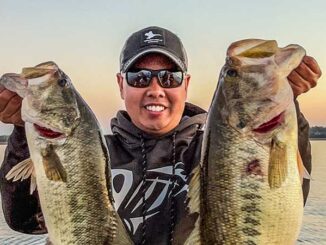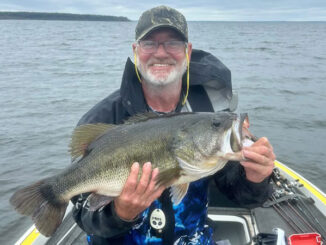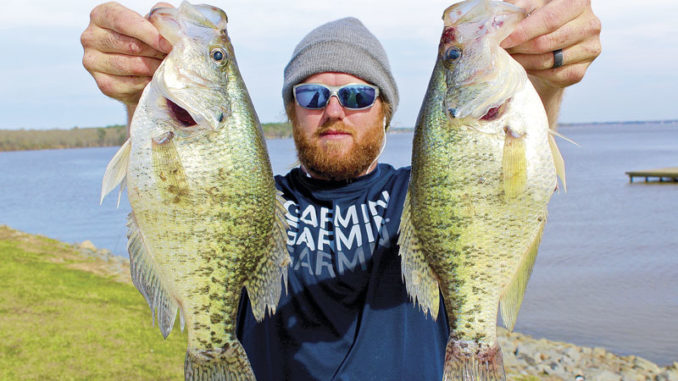
Renowned Oklahoma guide says technology has changed the way he targets crappie and other gamefish species. Here’s what he thinks.
Josh Jones kept his eyes glued to the LiveScope display screen at his feet. He slowly moved his boat across the water, rod cocked, reel loaded and ready to cast. He was just waiting for his target — a big bass — to appear on the screen. And then, there it was.
He fired out his bait and turned the reel handle a few times, never taking his eye of the screen.
“Oh my gosh, I got him. That’s a giant,” Jones said, netting the bass, which weighed 9 pounds on the scales a few seconds later.
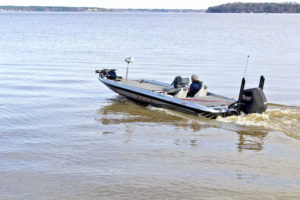
Five minutes later, the scene was repeated. Jones cast his Alabama rig out 12 to 15 feet past the fish, watched the rig sink and started reeling. The big bass started following it.
“Here he comes. Here he comes,” Jones said excitedly, watching the underwater action on his electronics. But the bait came to the top of the water untouched. “He followed it all the way to the boat. He was just looking at it. He never intended to bite it. He was over 10 pounds, easy.”
Jones was obviously disappointed. Without LiveScope, he would have never known what was going on.
A minute later, he saw yet another one.
“There’s another huge one,” he said, his bait barely hitting the water. “He sees it. He’s watching it. Oh my gosh. He’s got it! Oh, it’s a monster.”
But almost as fast as the fish hit, it let go. Jones dropped the tip of his rod and sighed, “He got off.”
Normally, if a fish gets off the hook, it’s over.
Technology has changed the game
Jones waited a minute, watching the LiveScope as the big fish swam back to where it came from. He gave him a couple of minutes and decided to make one more cast to see if the fish would react. It did.
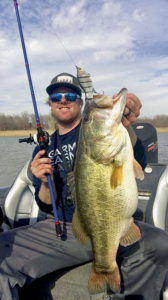
“He sees it. He’s coming up. He’s got it,” Jones said, almost like a play-by-play announcer on a football game. Seconds later, he grabbed the fish, which weighed nearly 9 pounds. He held the lunker up closer to his cell phone to give an outdoor writer a better look.
His cell phone? Yep. Welcome to 2020.
Jones, a renowned Oklahoma angler, was doing an hour-long interview over iPhone Face Time, wearing wireless earbuds and watching his LiveScope. The fish? His best five weighed 41.6 pounds. They were just innocent bystanders, probably wondering where the old guys with 5-foot fiberglass Speed Sticks and old flasher depth finders have gone.
“Technology has dramatically changed fishing,” Jones said. “It has become hunting for fish instead of fishing. Sometimes, it takes some of the fun out of it, but heck, if you want to go after the big ones, or compete in a tournament, you have to have it. I was the first one to ever get one of these LiveScope type units back when it was just regular Panoptix. I’m still learning every day. I’ll never go without one. And if they make something better, I’ll get it, too.”
A new way
Jones is ahead of the curve. He set the curve. Some argue, but there are always detractors when you are really good at what you do. He likes helping others become better fishermen. He said some of the things we’ve thought for years just aren’t true. LiveScope is helping bust some of those myths. He gladly shares that information and makes presentations to crappie anglers from all over.
It may sound strange to informed anglers to hear about Jones bass fishing. He is best known for changing the crappie-fishing world in the past two years, when some of his videos got more than a million views. A 32-year-old crappie guide from Kiefer, Okla., Jones has the maximum number of Facebook friends allowed — 5,000 — and fishes every day when he’s not working. Some of the best crappie fishermen in the world will stop and listen to every word he says at a tournament weigh-in. People in the crowd whisper, “That’s that Josh Jones guy.”
Earlier this year, he injured his knee, and the resulting surgery interrupted his guiding. But he couldn’t stop fishing, and he wanted a break from daily crappie angling. Part of his healing process was returning to his first angling love, bass fishing. He found that the LiveScope was equally useful for both.
“I love catching big fish, so the transition was easy,” he said. “I plan on still doing crappie guiding and crappie fishing, but I am enjoying trying out competitive bass fishing, too. I don’t know where this will take me, but I do think it will be fun. I don’t have to win every tournament; I just want to be consistent and take home a check. There are lots of great fishermen out there and it’s very competitive.”
Fish behavior
The new technology has allowed Jones and other anglers using it to learn tons about fish behavior.

“It’s amazing, but the fish are generally terrified of boat and motor noises,” he said. “You can see fish 20 feet out from the boat on the scope, step on your trolling motor, and they are gone, either swimming away or holing up deep in the brush. But sometimes, they’ll actually swim up closer and stare at the trolling motor. In the summer, when it’s hot, I’ve even had them swim up under the boat and come up from 15 feet deep to 5 feet deep to get in the shade. We would have never known that without LiveScope. It’s crazy.”
Nine times out of 10, Jones sees a reaction from fish that see his bait. It’s good when they see the bait above them, lift their heads and look at it. When that happens, the fish usually bites. But other times, when they see a lure, they will look and “swim off 100 miles an hour,” said Jones, who has learned that’s a time to downsize your lure and be extra slow and quiet.
“LiveScope has taught me that in most lakes, fish all over the lake in deep water, shallow water and in between, pretty much all year-long,” he said. “I’ve caught 3-pound crappie in 6 foot of water when it was 35 degrees. No one knew, and I don’t think anybody tried to catch them there.”
Know when to move on
Whether it’s bass or crappie. He has also learned that sometimes, it’s time to move on.
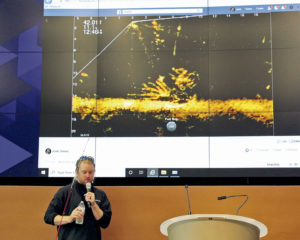
“When you see a giant fish, and he won’t bite, you’ve got to learn to move on,” he said. “If he isn’t reacting positively to your bait in one or two casts, don’t waste a lot of time. I’ve actually hit them in the head with the lure, and they don’t move. I guess they are asleep, or some weather condition like high pressure has them locked up. Sometimes fishing pressure makes them numb to a bait. It’s hard to do, but if you aren’t getting a reaction, move on.”
What’s next with technology?
“I don’t see how it could get better, I really don’t,” he said. “They asked me, and I can’t think of anything. But you have to have an open mind, just like with development of the iPhone. People think every year that they can’t do anything else, and then look, they are bigger and better.”
When the crappie bite gets hairy
When it comes to putting the bait right in front of a crappie’s mouth, it often doesn’t matter what color you use.
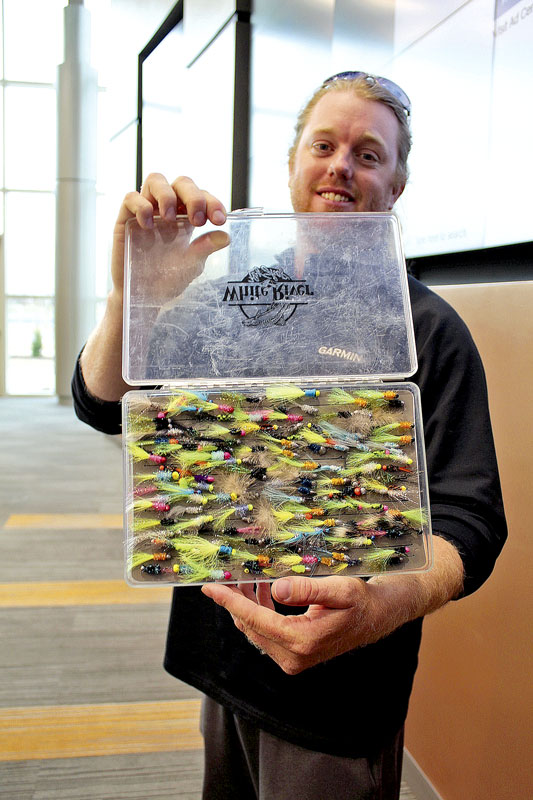
“I’m not really much of a color guy,” guide Josh Jones said. “I used to be, and sometimes it does make a difference, but when you are using a LiveScope and dropping it right on the fish’s head, they are either going to hit it or not.”
One thing Jones has discovered is that under these conditions, a hair jig gets more bites and catches more fish.
“The smaller-profile bait is less likely to spook them, and they must like hair jigs, because that’s about all I use much of the year,” he said. “You have to really pay attention, though. Most of the time, the jig is so light, and the bite is so light — especially with big ones — that you need to watch your line or feel your line. You won’t get the thump like you do with a big plastic bait.”
One of his favorites is the Crappie G jig, hand-tied in Louisiana. Jones likes to fish it with a bell sinker up the line from the jig and pegged so it won’t move, but keeps the bait down.
He still fishes shiners and likes plastics, too, but the hair jig is his go-to crappie killer.

